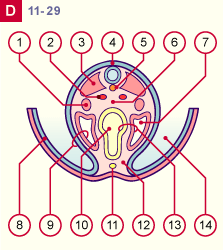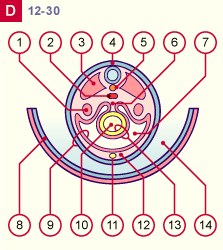
1
2
3
4
5
6
7 |
Nephrogenic cord
Aortae
(their fusion occurs in stage12)
Dermatomyotoma
Ectoblast
Notochorde
Mesenterium dorsal
Intraembryonic coelom |
|
|
|

8
9
10
11
12
13
14
|
Amnion
Somatopleura mesoderm and
ectoderm
Gut
Allantois
Mesoderm
Splanchnopleura mesoderm and
endoderm
Amniotic cavity |
|
|
|
Fig. 12
The embryo becomes totally enveloped by the amnion now. The intraembryonic coelom encloses the gut and temporarily forms a ventral mesenterium, that attaches the gut to the ventral abdominal wall.
Fig. 13
The ventral mesenterium has disappeared and, except for the umbilical cord, the embryo is completely surrounded by the amnion (later the peritoneal cavity will form at this level).
|

